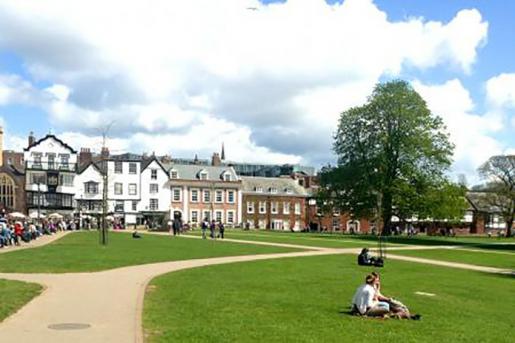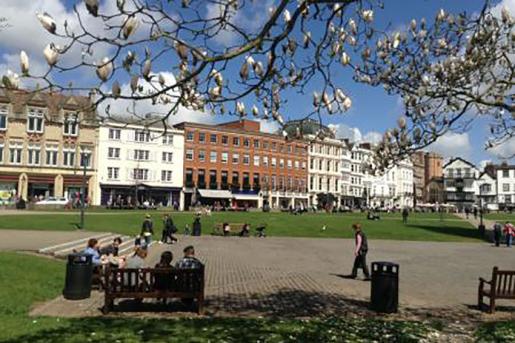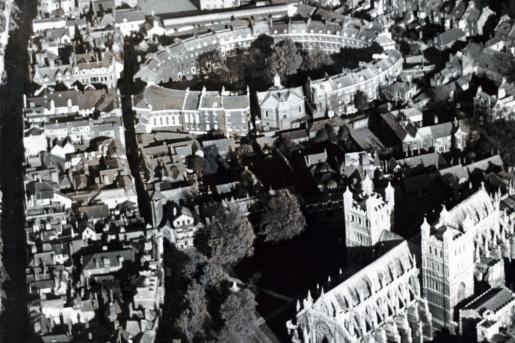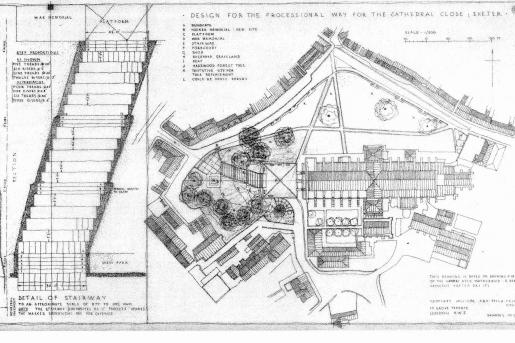- Public Park
The Cathedral Close has a long and complex historic development. The principal interest of the designed landscape today is the contribution made by Sir Geoffrey Jellicoe in the early 1970s. All the elements of the Jellicoe scheme survive essentially intact and comprise the Processional Way of shallow York stone steps linking Broad Gate to a granite-paved square in front of the West Front of the Cathedral, ground modelling & tree planting, an extension to the Green and a new low stone boundary wall along the Cathedral Yard and The Close.
From at least 1270, the Close was main burial ground of Exeter, and it is still consecrated ground. It was temporarily put out of use as a burial ground in 1637 when Bart's Yard was consecrated, and it does not seem to have been brought back into use until at least the 1680s. There are references to it being levelled in soon after 1637, so presumably that is when it started to become an ornamental/recreational landscape. This is confirmed by the attached copies of contemporary prints. It is clear that in the C18 it was being used at least in part as public walks with tree-lined paths, some of which follow the line of the paths today (especially the one which runs NW from the Cathedral). The Close is a superb designed landscape comprising many elements: listed buildings - many Grade I & II*, the Hooker statue, the original old river-stone paving extending along The Close & New Cut, under the Mayor Patch bridge spanning the City Wall, to Southernhay - are all of a high quality. It is of special historic and archaeological interest as an ancient burial ground with underlying archaeology from the Roman and Saxon periods. It is interesting to note the following quotation from Thomas Sharp’s plan, Exeter Phoenix a plan for rebuilding, (Architectural Press 1946) : ‘The Close at Exeter has a peculiar quality of personality that is hard to define, impossible not to be aware of, difficult to get away from. There are many solid, beautiful, quaint old-world and historic squares in England: but there are very few gay ones. ….the general effect is, like that if the front at Brighton, gay. Almost continentally so.’ Thomas Sharp also advocated the removal of St Mary Major Church, which he described as ‘an Imposing Ecclesiastical Edifice whose tower vies with the Cathedral in size but not in looks… This Ediface, it is hoped, will eventually removed, the Cathedral authorities being themselves alive to its unsuitability’ St Mary Major was eventually demolished in 1971 and the City’s Archaeological Field Unit carried out a major excavation, finding remains of the Saxon minster and the Roman Bathhouse & Basilica. By the time the Archaeologists had completed their work, in 1974, the whole area was a complete visual disaster with cars parked everywhere - outside the West Front, in Little Style and under the elms along Cathedral Yard. The City Planning Department and the Dean & Chapter worked closely together on a comprehensive regeneration for the Close. The Dean and Chapter were persuaded to commission Sir Geoffrey Jellicoe, as an eminent landscape architect, to prepare a landscape scheme for the Close. The Cathedral Close is an important example of the work of Sir Geoffrey Jellicoe, one of the most significant landscape designers of the twentieth century. The design is an important example of his work in an urban context where he sought to provide an appropriate setting to a significant building. Unlike many comparable examples of his work (for example the Bancroft Gardens, Stratford upon Avon which formed the setting for the Shakespeare Memorial Theatre), the Cathedral Close survives substantially intact and remains a highly effective designed landscape. The main element of Jellicoe's design was a new Processional Way of shallow steps to link Broad Gate to a new square at the West Front of the Cathedral, ground modelling and tree planting on the site of the Roman remains to create a sense of enclosure and to act as a foil to the new buildings that replaced the Globe Hotel, (described by Pevsner as ‘the scrappy post-war corner’) and the undistinguished post-war building for the Cathedral School, and a new low wall boundary wall to the Green along the entire length of Cathedral Yard and The Close. The Processional Way was one part of a comprehensive regeneration of the Close by a collaboration of the City Council and the Dean & Chapter with the car parking removed, an extended Green, a new stone wall along the entire length of the Green, ground modelling and tree planting (the species of the trees was specified by Jellicoe), and repaved surfaces in front of the Royal Clarence Hotel. The Bishop’s Palace, approached through the gatehouse with a fourteenth century arch, stands in generous grounds stretching from the south east corner of the Cathedral to the city walls. The Palace dates from 1224 and although the early history of the garden is not recorded, it is perhaps the oldest in Devon. The medieval buildings were extensive but were truncated and remodelled from the sixteenth to the eighteenth centuries, they were given their present exterior largely by Ewan Christian in1846-48 for Bishop Phillpotts. Butterfield carried out some further alterations in the 1870’s. Celia Fiennes noted in 1695 that ‘There is a long walk as well as broad, enclosed with rows of lofty trees which make it shady and pleasant, which went along a ditch and bank on which the town wall stands.’ . The eighteenth century maps of the city show a garden layout which is largely retained. In 1805 Mrs Price of Chester thought the grounds were beautiful and approved of the paths which were not paved but made of ‘green sod.’ Extending to around 3 acres, the grounds contain some fine trees and a wild orchard garden. The modern sculptures give added interest. The Cloisters may have been built originally by Bishop Brewer. A decree published in 1638 by Bishop Hall, following the consecration of Batholomew Yard in 1637, demanded that the kitchen garden in the cloisters be removed and the area be reinstated as the burial ground for those dying within the cathedral precincts. The cloisters were demolished in 1656-7, probably by the Exeter City Corporation which set up a serge market here (Pevsner p387). The Cathedral Precincts comprising the Close, together with the Cloisters and Bishops Palace, is of special historic interest in the national context,
The buildings in Cathedral Close and Cathedral Yard are listed Grade I, II* & II.
Cherry & Pevsner: The Buildings of England – Devon, 1989: 410
Exeter City Council Minutes




